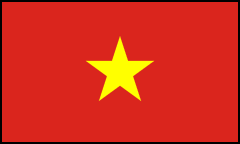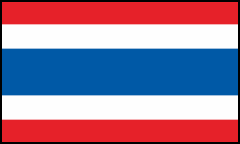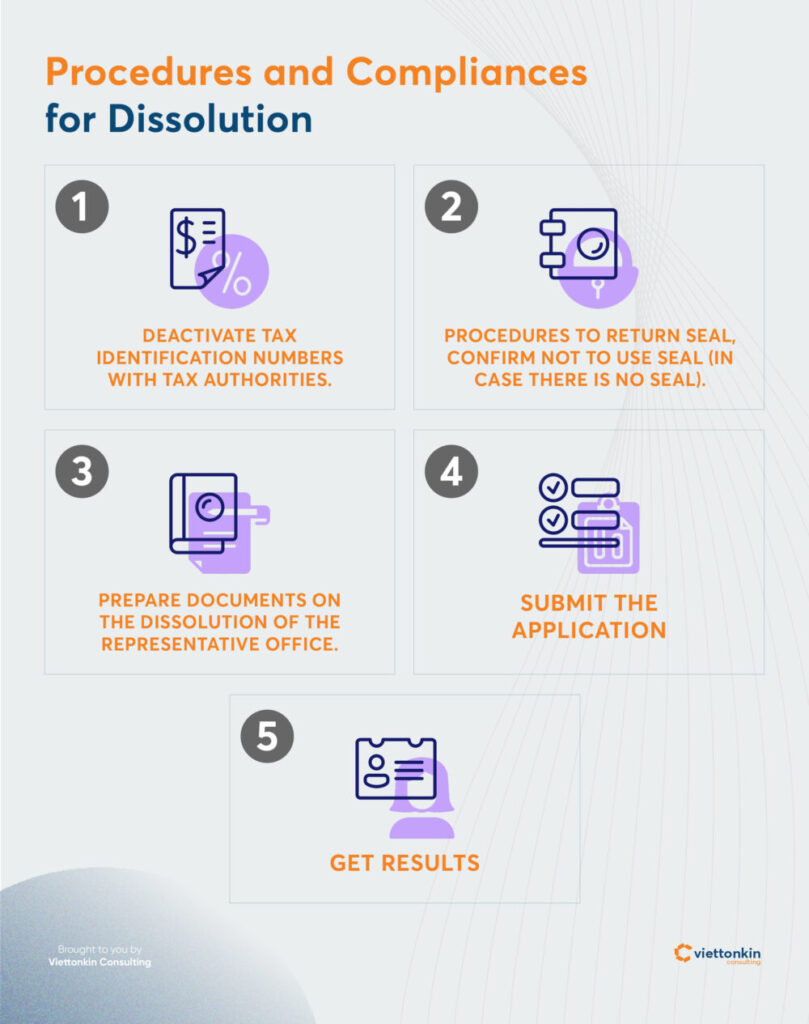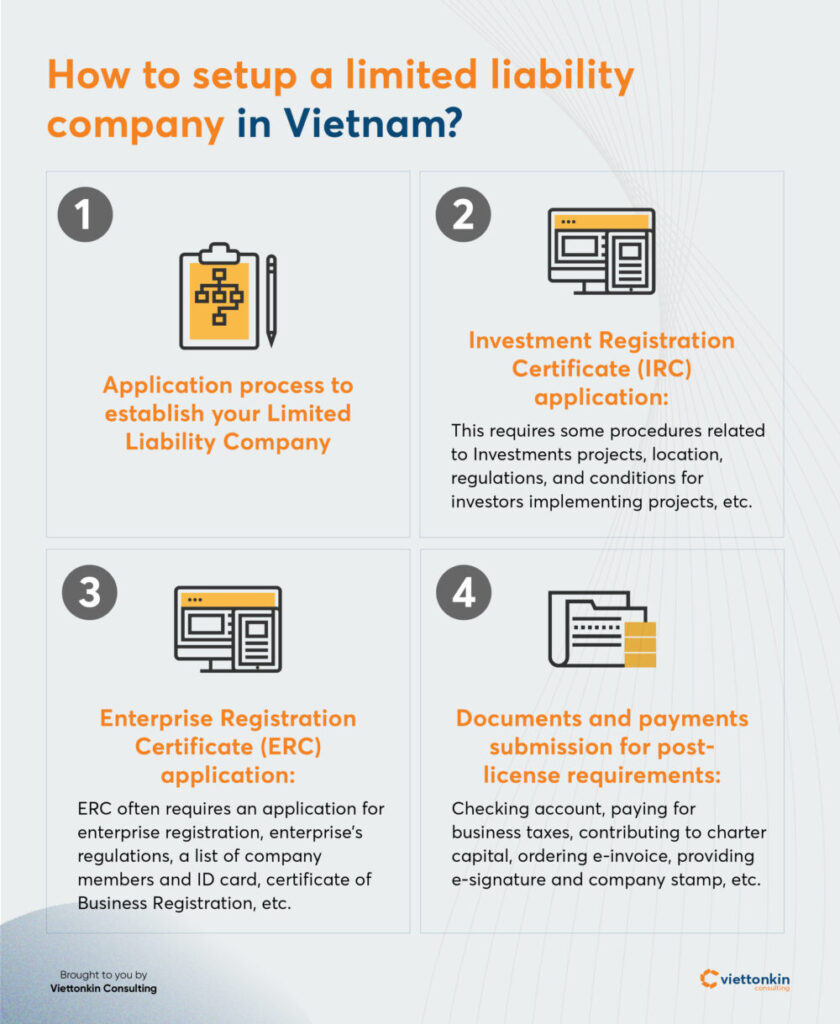The Representative Office (RO) has no function of profit generating, but functions such as researching, approaching market expansion, promoting brands, products, contacting customers … So, it can be fairly essential to get one. Thus, how is the procedure and compliance how to establish representative office in Vietnam as well as dissolution? The following article of Viettonkin Consulting will share useful information about the RO establishment and termination procedures and related issues. Let us find out with us for useful information for doing business in Vietnam.
Procedures and Compliances how to establish representative office in Vietnam
READ MORE: How to establish a Representative Office in Vietnam
Compliance for representative offices (ROs)
Setting up a Representative office (ROs) is one of the simplest and fastest ways to establish a legal entity in Vietnam. Their report requirements are also more simple compared to FOCs.
READ MORE: Legal Service to find out more about how we can help tackling your problems and protecting your rights
Because ROs are forbidden from directly conducting profit-generating activities and are limited to market research, developing trade contacts, and gathering information on regulations and laws, their compliance requirements are also more simple than FOCs.
Procedure requirements check - list (2021 update)
- Tax and accounting procedures
Mandatory:
- PIT finalization
- PIT finalization for individuals with multiple sources of income or have direct income from abroad
Tasks to note:
- Complete cash book and petty card with appropriate invoices and vouchers for tax inspection
- Re-audit the tax return - payment and tax receipts
- Cross-check the balance - tax status with the tax agency
- Annual activity Report
- Prepare and submit the Report on the operation of the office during the year to the Department of Industry and Trade
- Procedures for wage labor
Mandatory:
- Signing a labor contract, an employment contract appendix for the new salary and income for the year for each employee in the country.
- Provide appointment letter, confirmation letter of annual income for foreign workers.
- Registering and adjusting the salary scale system, labor regulations, labor agreements ... to update regulations and welfare policies.
- Complete information about the employee management book with content that needs updating such as days off, overtime hours, discipline, salary increases, …
Tasks to note:
- Performing income verification procedures, issuing PIT withholding vouchers for seasonal employees, employees earning direct income from abroad.
- Determine a list of personnel subject to PIT self-finalization with the tax office.
Procedures and Compliances for Dissolution
In order to carry out the procedures for dissolution of a representative office in accordance with the promulgated law, the enterprise needs to fully perform the following steps:
Step 1: Deactivate tax identification numbers with tax authorities.
Step 2: Procedures to return seal, confirm not to use seal (in case there is no seal).
Step 3: Prepare documents on dissolution of representative office.
Step 4: Submit the application
Step 5: Get results
Procedures for Tax Identification Number (TIN) deactivation
In order to be able to validate the Tax Identification Number of the representative office, you need to submit the application to the administrative tax office. Types of papers and documents include:
- Official letter on TIN deactivation.
- The decision to close the representative office of the board of members (LLC) / the board of directors (shares) / owner / business owner (private).
- Meeting minutes of the Board of Directors / Board of Members on the dissolution of the Representative Office.
- Power of attorney for the company's filers.
Instructions to return the seal, confirm not to use the seal of the representative office
According to the Enterprise Law 2014, effective on July 1, 2015. In case representative offices have been established before this time, when completing the procedures to close the representative office, it is necessary to submit a dossier to return the seal or confirm the seal is not used with the police. We would like to advise a set of documents for customers as follows:
- Official letter confirming no use / return seal.
- Decision to dissolve Representative Office.
- Meeting minutes of the Board of Directors / Board of Directors on the closure of Representative Office
- Power of attorney, a referral for the company submitter.
- Original seal registration certificate, seal in case you pay the seal.
Profile dissolution representative office
After completing the procedures for the code and the seal, the next job that the enterprise needs to do is to prepare papers and documents in the dossier set to close the representative office.
RO's profile that will include the following categories:
- Notice of dissolution of RO (Download the form in Appendix II - Circular 20/2019 / TT-BKHDT HERE).
- Decision of the Owner / Board of Directors / Business Owner / Board of Members on the closure of Representative Office. Or revocation decision of the competent state agency.
- Minutes of the meeting of the Board of Directors / Shareholders' Council (if any).
- Original certificate of representative office operation registration (can use a notarized copy).
- Seal (if any) or Certificate of unused seal of the police agency.
- Notice of tax termination.
- Request for supplementing and updating operation registration information for representative offices issued with investment certificates (Download the form in Appendix II-19 of Circular No. 20/2019 / TT-BKHDT HERE).
- Power of attorney / company referral for the applicant (FORM)
- List of number of employees or their benefits in RO (if any).
- List of debt amounts (including tax debt and social insurance debt) the business has not paid, a list of creditors (if any).
Submitting for closing representative office
When conducting the dissolution of a representative office, the enterprise needs to send a notice to the Business Registration Office where the representative office is located.
Next, businesses can apply through the following 2 ways:
Get results
From the time the registration office receives a valid application, it will take about 05 working days including: Examining the application => changing the status in the Database from registration of Representative Office to termination => out Notice of termination of Representative Office operation (if the application is valid).
In the event that the Registration Office checks the file and finds that there are errors or omissions, it will issue a Notice of amendment and supplementation of the file to the enterprise.
Notably
- Responsibilities for the employees: when wishing to dissolve representative offices, domestic or foreign traders need to give advance notice, fulfill the obligation to pay wages, terminate rental contracts, labor contracts ...
- With tax authorities: need to fulfill all tax-related obligations and procedures.
- If the RO has been suspended for more than 1 year but the business owner does not notify the Business Registration Office or the tax authority, then the certificate of operation registration will be revoked. To avoid the situation of being revoked, enterprises need to do temporary business suspension procedures for the representative office if they intend to suspend the business.
- In case the RO location is not in the territory of Vietnam, the enterprise should dissolve in accordance with the regulations of that country. Then, within 30 days, to notify dissolution of the representative office to the Business Registration Office where the head office is located.
A Limited Liability Company (LLC) according Enterprise Law Vietnam can be set up with only one shareholder who can be of any nationality other than Vietnam. Normally, setting up LLC is believed to be simpler compared to large corporations thanks to smaller scale (up to 50 members), so that investors usually consider this as a worthy choice. Therefore, in this following article we will provide you with a checklist to establish a LLC according Enterprise Law Vietnam in this article.
Overview of Limited Liability Company in Vietnam
- Is one of the four types of enterprises in which domestic and foreign investors are allowed to do business in Vietnam under Vietnam's Enterprise Law.
- Can be totally or partially foreign-invested.
- Is simpler to set up as compared to a large corporation in Vietnam.
- Is a legal entity formed from the capital contribution of each member to the company. The number of members must not be over 50.
- Especially, an LLC member's liability for the company's financial obligations will depend on his/ her share of the equity, not their personal property.
- Investors must do their due diligence to work out the acceptable market entry option suitable to their appropriate business lines and specific requirements.
So, a Limited Liability Company in Vietnam is formed based on the capital contributions of its members. Capital contribution refers to the entire assets contributed to constituting the charter capital of the corporate .
Therefore, a Limited Liability Company’s shareholder can take part in the whole growth of the corporation while their liability and financial obligations are restricted to the quantity of investment they contributed to the company’s charter. (Related article: Limited Liability)
Similarly, just in case of a one-member or single-member indebtedness company, this structure has just one member who is additionally the corporate owner. For this reason, this person must be responsible for all relevant debts and obligations of the corporate to the extent of his/her capital contribution to the corporate .
READ MORE: The Global Company Registration to find out how Viettonkin can help globalize your business.
How to set up a Limited Liability Company?
In 2021, Enterprise Law Vietnam has a lot of preferential investment policies in various economic sectors in Vietnam for foreign investors.
Accordingly, Enterprise Law Vietnam, when conducting investment to establish a company in Vietnam, foreign investors need to learn and grasp the provisions of the current law to ensure the most optimal conditions when investing and doing business in Vietnam.
With the desire to best support legal procedures, tax for foreign investors to set up foreign invested companies in Vietnam, Viettonkin Consultant provide the process details to establish a foreign-invested LLC as follows:
Corporate structure
- Member’s council: This is often the body with the very best position for creating decisions of the corporate. It is mandatory that the Member’s council must hold a minimum of one meeting per annum .
- The chairman of the Member’s council: An LLC has the duty to select a member to become the council’s chairperson who can be the director or general direct of the company. Note that the applicable tenure of the chairperson is within a period of 5 years.
- Director/Director General: Main responsibilities of director/director general is to manage daily business operations of the indebtedness company, also as hold the liability for his/her exercise of rights to the Members’ Council.
- Supervisory Board: If your multi-member LLC in Vietnam is a state enterprise or a subsidiary of a state enterprise in Vietnam, then you must establish a Supervisory Board as stipulated by Article 54, Law on Enterprise 2020. Other circumstances on whether this Board should be formed or not is at the discretion of the LLC itself.
Registration Process
In general, you are required to go through the following procedures to set up your Limited Liability Company:
Investment Registration Certificate (IRC) application
IRC application check-list:
- Investment project number.
- Name and address of the investor.
- Name of the investment project.
- Objective and scale of the investment project.
- Location of the investment project; area of land used.
- Investment capital of the project (including investor's contributed capital and raised capital), capital contribution and mobilization schedule.
- Duration of the project.
- Investment project execution schedule: capital construction progress and work put into operation (if any); The progress of implementing the main objectives and main items of the project, if the project is implemented in phases, must specify the objectives, duration and contents of each stage.
- Investment incentives and supports and bases and conditions for application (if any).
- Regulations for investors implementing projects.
- Conditions for investors to implement the project (if any).
Business sectors that need sub-licenses are travel (international/domestic business license), printing (printing operation license) and security (certificate of social security), among others.
Enterprise Registration Certificate (ERC) application
ERC application check-list:
- An application for enterprise registration;
- Enterprise's regulations;
- List of company members, for limited liability companies with 2 or more members;
- ID card or passport of a limited liability company member;
- Certificate of Business Registration / Business Registration Certificate for members who are organizations and accompanied by personal identification papers, the authorization decision of the authorized representative organization's.
- Capital contribution decisions.
- List of authorized representatives (for members who are organizations);
- An investment registration certificate for the investor has been issued.
- Other documents in special cases;
READ MORE: How to get a Legal Representative for a Company in Vietnam
After a business is legally registered, an ERC is going to be issued by a business registration agency. An ERC may be a document, often softcopy or hardcopy, that contains information on enterprise registration.
Documents and payments submission for post license requirements
- Opening a checking account , paying for business taxes, contributing to charter capital, ordering e-invoice, providing e-signature and company stamp, etc.
What’s next?
Arring staff, tax, and annual reporting . You need to register hired employees with the social insurance department.
Foreign employees also will get to have the specified work permits to figure in Vietnam. This may take longer as Vietnam’s borders remain closed, however, this is still possible and we Viettonkin can assist you in acquiring the needed documents and entry permits.
You have to pay the business license tax. They are also subject to corporate tax (CIT), VAT (VAT), and private tax (PIT). Depending on the line the corporate could also be eligible for CIT reductions within the first years of operation.
Limited liability companies are required to undertake tax audits that checks all revenues and expenses during the tax term to determine payable taxes.
How long does it take?
The whole registration process can take 2 - 3 months in total. However, the time may slightly vary depending on the business activities or sectors and completeness of documents. We recommend finding support from a consulting agency to assist you in the whole process.
To sum up, setting up a foreign-owned limited liability company in Vietnam requires some procedure a bit more complicated than a company with local capital and takes some time to prepare. However, everything will become easier if you understand the whole process of establishing a new business in this promising country. Viettonkin hopes that this information will assist you in any cases. Do not hesitate to contact us if there are any difficulties, Viettonkin is here to help!
Vietnam Visa Online
Some nationalities need a visa in advance for all visits, some don't. As of January 2019, citizens from 24 countries actually have a visa exemption for 15 days. If your visit to Vietnam is brief, you may not need to bother with a visa at all! However, the list of exemptions can change, so check with the official authorities in your country before you go.
Those whose country is not in the list of exemptions, until recently, there have been two methods for you to apply for Vietnam visa online: a Visa on Arrival (VOA) via online visa agents; or an e-visa.
Regardless of which method you use, your passport must have at least six month's worth of validity left to receive a visa for Vietnam.

Vietnam E-Visa System
Now, citizens from 80 countries (including the United States, Canada, and European Union) can apply online for an e-visa. As usual when applying for a travel visa, this has to be done before you land in Vietnam. Without proof you'll be allowed into Vietnam upon arrival, your airline probably won't even allow you to board the plane.
List of 80 countries can apply for vietnam e-visa
https://evisa.xuatnhapcanh.gov.vn/documents/20181/117155/Vietnam-Evisa-nation-list.pdf//21e0f88f-d8a0-48b8-bfdb-a0f82b0853e2
To apply for your e-visa to Vietnam, you can click here:
https://evisa.xuatnhapcanh.gov.vn/en_US/web/guest/trang-chu-ttdt
Vietnam implemented an e-visa system on February 1, 2017. Although a little buggy at first, the new system has greatly simplified the process of getting a visa for Vietnam.
You'll need a scan/digital photo of your passport as well as a recent, digital photo (4 x 6 cm) of yourself on a neutral background (no hats or glasses). After uploading images, you'll pay the US $25 fee online. Three days later, if all goes well, you'll receive an email with your e-visa attached. Print this and bring it with you to Vietnam!

However, tourists who want to apply for Vietnam e-visa should also take note on these issues:
- There have been reports of visitors being deported due to incorrect details (such as wrong date of birth or misspelt names) on the online application form. If you do apply for an e-visa, double-check that all the information you provide is 100% accurate.
- Many fake e-visa websites have popped up. These fraudulent sites claim to be official but are actually involved with identity-theft rings. Ensure you are applying on the official government e-visa website (the domain ends with gov.vn); don't trust search engine results or the ads at the top.
Vietnam Visa on Arrival
Before the e-visa system was rolled out, the most common way for travelers to get a visa for Vietnam was to first apply online for a Visa Approval Letter through a third-party processing agency. This is still an option if you are having trouble applying for an e-visa.
The Visa Approval Letter is not to be confused with an e-visa; these official letters are issued by private companies rather than the Vietnamese government and do not guarantee entry into the country.
The visa on arrival only works for arriving in one of the major international airports: Saigon (HCMC), Hanoi, Nha Trang, Da Nang etc. If crossing overland into Vietnam from a neighboring country, you must have already arranged a visa either online or from an embassy.

The process of obtaining a visa on arrival for Vietnam is as follows:
Step 1: Apply for an Approval Letter Online
Travel agencies charge around US $20 (payable via credit card) to process your online application; processing time usually takes 2–3 working days, or you can pay more for rush service.
Applying for a stay longer than the standard 30-day visa requires more time (7-10 working days) to process. On rare occasions, the government may ask for more information such as a scan of your passport. The travel agency handles all communication with you, but a request for more information will certainly delay your approval processing. Err on the side of caution—start apply for Vietnam visa well in advance of your flight date.
There are many visa agents, but there are some inefficient cut-priced operators out there. It's recommended to stick to well-established companies; the following two are professional and efficient:
Vietnam Visa Choice (www.vietnamvisachoice.com): Online support from native English-speakers. This agency also guarantees your visa will be issued within the time specified.
Vietnam Visa Center (www.vietnamvisacenter.org): Competent all-rounder with helpful staff well briefed on the latest visa situation. Offers a two-hour express service for last-minute trips.
Step 2: Print Your Approval Letter
Once approved, the travel agency will email you an image file of the scanned approval letter which must be printed clearly and legibly. Print a couple of copies just to be safe.
Don't be surprised if you see lots of other travelers' names on your approval letter—it's normal for your name to just be included on a list of approvals for that day!
Step 3: Book your flight
If you haven't already booked your flight to Vietnam, do so after receiving your visa approval letter. Flights can be booked without proof of visa, however, you'll need to show proof of a visa or the printed approval letter before being allowed to board your flight.
Step 4: Arrive in Vietnam
Upon arrival, you should approach the visa-on-arrival window to request the visa application form. They may ask for your passport, Visa Approval Letter, and passport photo(s) to expedite processing as you complete the visa paperwork in the waiting area. Write down essential information such as your passport number, issue date, and expiration date before handing it over.
Two passport photos are officially required, but the office may only ask for one; these should loosely conform to the official size of 4 x 6 centimeters. If you do not have photos that meet the requirements, some airports have kiosks where you can take them for a small fee.
You will take a seat to complete the short-but-confusing application form then present it at the window. Once your name is called, you'll receive your passport with a one-page, Vietnam visa sticker inside. Depending on the queue, the entire process takes around 20 minutes.
Step 5: Pay the Visa Fee
You will have to pay a visa-on-arrival fee when presenting your paperwork. For a 30-day, single-entry visa on arrival, the fee is typically US $25; paying the exact amount with U.S. dollars is preferred, otherwise you may be issued change in the local currency (subject to a bad exchange rate). This is separate from the fee paid to an agency for the approval letter.
After paying at the window, a visa will then be added to your passport and you are allowed to enter Vietnam.
Thanks to the advantage of Technology, foreign tourists who want to apply for Vietnam visa now no longer have to directly contact Vietnamese embassies and consulates around the world, which is normally more costly and time-consuming.
If you want to know clearly the procedure to apply for Vietnam visa online please contact us or email to info@viettonkin.com.vn
A representative office is the presence for a foreign company in Vietnam. Representative office is intended to promote business opportunities,
 English
English











